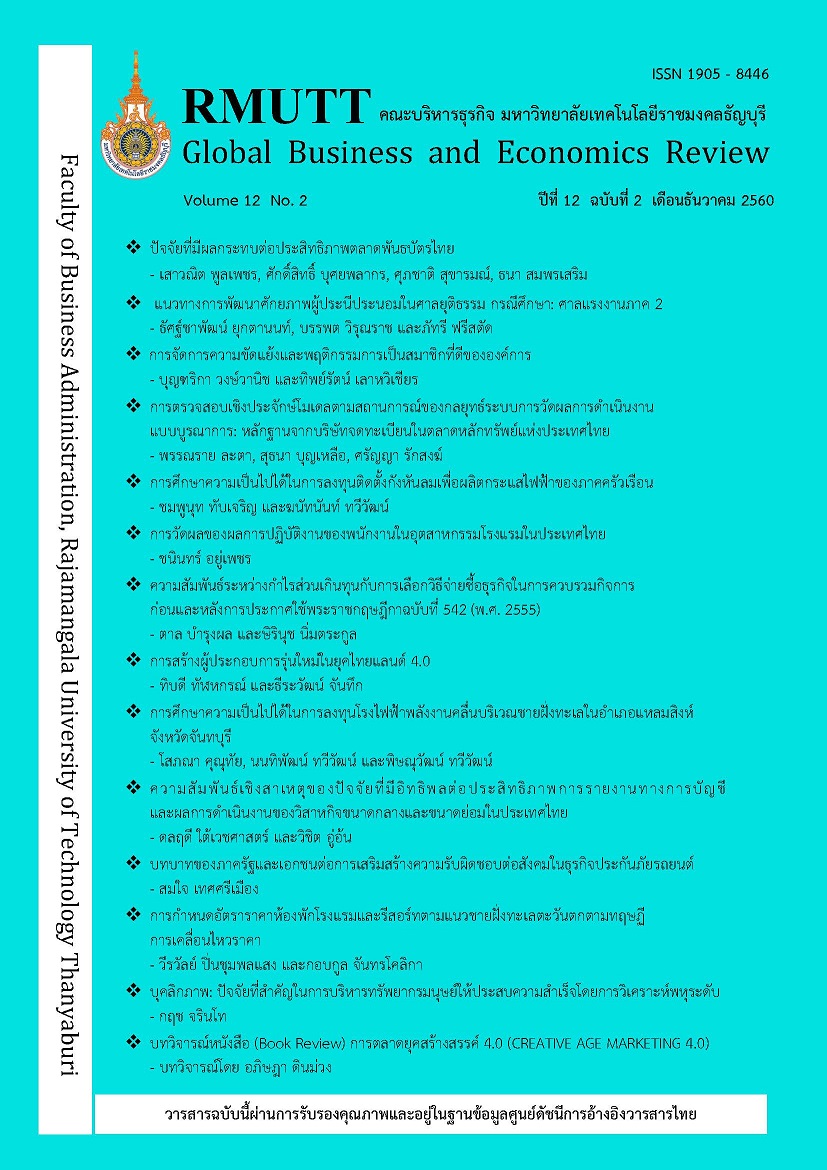การศึกษาความเป็นไปได้ในการลงทุนโรงไฟฟ้าพลังงานคลื่น บริเวณชายฝั่งทะเลในอำเภอแหลมสิงห์ จังหวัดจันทบุรี
Keywords:
Power Plant, Wave Energy, FeasibilityAbstract
The study aimed to (1) explore the coastal area of Amphoe Laem Sing Changwat Chanthaburi (2) identify appropriate technology to produce electricity from wave power farm in Amphoe Laem Sing (3) perform the financial feasibility of the project. The primary data was collected by participant observation method and in-depth interviews and the secondary data was collected from academic documents of various sources including the internet. Both types of data were used in descriptive and quantitative analyses. The analytical tools were weighted average cost of capital (WACC), net present value (NPV), internal rate of return (IRR), modified IRR (MIRR), profitability Index (PI). The study revealed that the coastal area in Tambon Pak Nam Laem Sing was suitable for installation of wave energy converters because there was no maritime traffic in the area and the average wave height was around 0.76 meter enough to generate electricity from Drakoo wave energy converters which required the waves height between 0:20 to 5:50 meters. Efficient power conversion was around 55 percent capacity. The wave energy convertor could replace breakwater with less environmental import. The financial feasibility based on project life of 21 years and WACC at 5.82 percent showed that the project was infeasible since NPV was -130,101,979.69 Baht, IRR was 1.62 percent, MIRR was 3.73 percent, and PI was 0.66. Thus, the electricity production business alone was not feasible at the time since the technology was still at high cost. However, the project was a better alternative for breakwater in term of cost effectiveness.
References
กรมทรัพยากรทางทะเลและชายฝั่ง. (2559). สถานการณ์กัดเซาะชายฝั่งทะเลไทย. สืบค้นจาก http://marinegiscenter.dmcr.go.th/km/coastalerosion_doc9/#.VXFeZdLtmkp
การไฟฟ้าฝ่ายผลิตแห่งประเทศไทย. (2559). สัดส่วนการใช้เชื้อเพลิงผลิตพลังงานไฟฟ้าในระบบของ กฟผ. ปี 2558. http://www.egat.co.th/index.php?option=com_ content&view =article&id=579&Itemid=116
คณะพาณิชยนาวีนานาชาติ มหาวิทยาลัยเกษตรศาสตร์ วิทยาเขตศรีราชา. (2556). รายงานโครงการวิจัยการศึกษาและวิจัยเพื่อพัฒนาการผลิตไฟฟ้าจากพลังงานคลื่นสำหรับประเทศไทย. ชลบุรี: มหาวิทยาลัยเกษตรศาสตร์.
จุไร ทัพวงษ์ วิชญะ นาครักษ์, วิโรจน์ นรารักษ์, สมศักดิ์ มีทรัพย์หลาก, สุภาสินี ตันติศรีสุข. (2555). การวิเคราะห์โครงการและแผนงาน (Project and Program Analysis). กรุงเทพฯ: มหาวิทยาลัยสุโขทัยธรรมาธิราช.
สิตาวีร์ ธีรวิรุฬห์. (2559). ปัญหาการกัดเซาะชายฝั่งทะเลของไทย. สืบค้นจาก http://www.parliament.go.th/ewtadmin/ewt/parliament_parcy/ewt_dl_link.php?nid =30789
สันต์สิริ ศิริสรรหิรัญ. (2555). การศึกษาความเป็นไปได้ของการผลิตไฟฟ้าจากพลังงานคลื่นน้ำและการป้องกันการกัดเซาะชายฝั่ง กรณีศึกษาปากอ่าวไทย. (ปริญญามหาบัณฑิต, จุฬาลงกรณ์ มหาวิทยาลัย).
สำนักนโยบายและแผนพลังงาน กระทรวงพลังงาน. (2557). แผนพัฒนาพลังงานทดแทนและพลังงานทางเลือก 25% ใน 10 ปี (พ.ศ.2555-2564). สืบค้นจาก http://www.enconfund.go.th/pdf/index/aedp25.pdf, 7 เมษายน 2557.
โสภณา คุณุทัย. (2559). การศึกษาความเป็นไปได้ในการลงทุนโรงไฟฟ้าพลังงานคลื่น อำเภอแหลมสิงห์ จังหวัดจันทบุรี. (ปริญญามหาบัณฑิต, มหาวิทยาลัยเกษตรศาสตร์ วิทยาเขตศรีราชา).
หฤทัย มีนะพันธ์. (2550). หลักการวิเคราะห์โครงการทฤษฏีและวิธีปฏิบัติเพื่อศึกษาความเป็นไปได้ของโครงการ (พิมพ์ครั้งที่ 2). กรุงเทพฯ: จุฬาลงกรณ์มหาวิทยาลัย.
Brigham, E. F. & Ehrhardt, M. C. (2005). Financial management theory and practice (11th ed.). Mason, OH: South-Western.
Hann-Oceane Technology Pte, Ltd. (2016). Drakoo wave energy convertor. Retrieved from http://www.hann-ocean.com, มิถุนายน 2558.
Koh, A., Ang, S. K., Brigham, E. F., & Ehrhardt, M. C. (2014). Financial management theory and practice. Singapore: South-Western.
Lin, S. A. (1976). The modified rate of return and investment criterion. The Engineering Economist, 21(4), 237-247.
Downloads
Published
How to Cite
Issue
Section
License
The articles published in this journal are the intellectual property of their respective authors.
The views and opinions expressed in each article are solely those of the individual authors and do not reflect the positions of Rajamangala University of Technology Thanyaburi or any of its faculty members. All components and content of each article are the sole responsibility of the respective authors. In the event of any errors, the authors shall bear full responsibility for their own work.








